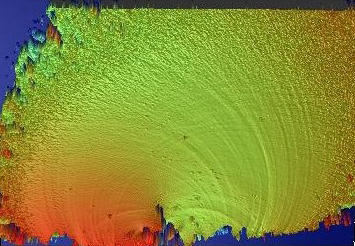
Optical profilometer image of the broken surface of a glass rod shows height of peaks (yellows and reds) and valleys (blues and purples) of the fracture surface in millionths of a meter. Curved ribs reveal the path of the stress waves through the glass. Image shows an area 1 x 1.3 millimeters.
The National Institute of Standards and Technology (NIST) recently issued a guide to Fractography of Ceramics and Glasses (NIST Special Publication SP 960-16), which aims to increase the use of fractography by scientists and engineers for the analysis of broken brittle materials.
Fractography is a powerful but underutilized tool for the analysis of fractured glasses and ceramics. It applies to fractures created under controlled conditions in the laboratory as well as material failures in real-life situations. It can identify the cause and origin of a failure, determine whether a material contains atypical flaws or if a part was simply overloaded or misused, or why one part broke but others did not. Fractography also can yield quantitative information about the loading conditions at fracture.
The guide emphasizes practical approaches for fracture analysis and problem solving. It also stresses fractography's value in other applications, such as routine mechanical testing and materials processing. As fractography is largely about pattern recognition, the guide is illustrated with 725 pictures and drawings to aid fractographers, including students, in identifying patterns. Additionally, it includes an extensive bibliography and a list of published case studies.
The guide may be downloaded in Adobe Acrobat (.pdf) format at www.nist.gov/public_affairs/practiceguides/SP960-16.pdf. Single print copies may be obtained free-of-charge by contacting George D. Quinn, (301) 975-5765, george.quinn [at] nist.gov (george[dot]quinn[at]nist[dot]gov). Requests for multiple copies will be reviewed on a case by case basis.

